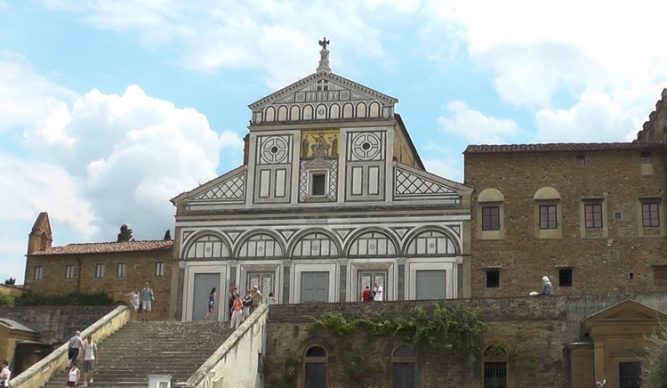Florence Oltrarno Now a World Heritage Site

Joining the city’s historical center, a number of landmarks in Florence’s Oltrarno neighborhood immediately across the Arno river have been declared Unesco World Heritage sites. The updated list includes the church and abbey of San Miniato al Monte, the neighboring church of San Salvatore al Monte, Le Rampe, Piazzale Michelangelo plus the Iris and the Rose Gardens (Giardino dell’Iris and Giardino delle Rose).
San Miniato
The basilica di San Miniato takes its name from the martyr St. Minias buried beneath it, a 3rd century Armenian who lived as a hermit near Florence, prosecuted for his Christian faith by the Roman emperor Decius. “This is the gate of Heaven” is inscribed in Latin above the church’s Holy Door, and one can see how truly fitting these words are upon entering and glimpsing the equally beautiful and welcoming interior.
The smooth walls, adorned with uncomplicated patterns, come alive as sunlight slants in through the windows. Every surface seems to be home to an architectural or artistic wonder of some sort. Classical-style capitals can be seen in the supporting columns of the church, taken from the remains of Roman buildings. One of the particularly striking floor panels contains every sign of the zodiac entwined in elaborate lace-like vines, creepers, and foliage — all etched in stone.
Works by some of the most famous Florentine artists of the late Middle Ages and the Renaissance can be found amidst the church’s plentiful adornments. Especially dazzling are the golden, Byzantine-style mosaics in the presbytery. The frescoes on the crypt’s vaulted ceilings were painted by Taddeo Gaddi, a follower of Giotto. Other remarkable frescoes include Michelozzo’s recently restored Chapel of the Crucifix, and traces of Paolo Uccello’s scenes of monastic life, which exhibit a groundbreaking use of perspective, a Florentine invention during the Renaissance.
The Chapel of the Cardinal of Portugal, added in 1473, is especially vibrant. It houses the tomb of Cardinal Iacopo of Lisbon, who fell ill and died while visiting San Miniato in 1459. Constructed in the Renaissance style, blue and white ceramics by Luca della Robbia adorn the ceiling, standing out against a backdrop of eye-popping yellow and green geometric patterning.
Though the Florence skyline, from Brunelleschi’s imposing dome to Santa Croce’s spire, is fully visible from the church’s steps, San Miniato is free from the crowds of the historical center, standing apart from the selfie-crazed chaos of Piazza Michelangelo down the street. The church’s grounds are a tourist-free oasis floating above Florence, peace and solemnity prevailing as one walks through the cemetery or sits at a pew inside, looking up at the intricate ceiling.
The adjoining monastery, founded in 1018 by Hildebrand, Bishop of Florence, is still active. Work, contemplation, and prayer remain ever vital to the Benedictine monks, whose lives hum on behind the basilica’s façade of white and green Tuscan marble and the monastery’s plain brown walls. It is the most recognizable feature of this jewel of Romanesque architecture, sometimes even referred to as “Proto-Renaissance.” The quietly stunning façade makes it easy for awestruck onlookers to miss the sweeping view of the city just behind them. (tyler bunton)
Piazzale Michelangelo
Below San Miniato is Florence’s iconic overlook dedicated to visitors and residents enjoying and photographing the view. The bronze copy of Michelangelo’s David is currently under wraps, undergoing restoration.
Iris Garden
Tucked into the sheltered corner of Piazzale Michelangelo, an almost secret Iris garden with more than 2,500 different varieties is in full bloom during spring. Iris lovers of the world have donated a number of plants.
The secluded area is a relaxing escape, filled with only distant echoes of Florence. The Italian Iris Society, headquartered in Florence for its historical attachment to the flower, maintains the flowerbeds and sponsors an annual international iris competition.
Rose Garden
Filled with thousands of plants, 350 different species of roses, fountains and sculptures by Jean-Michel Folon, the Rose Garden is open free of charge 365 days a year.
Le Rampe
Built between 1872 and 1876, Le Rampe are divided into three levels containing multiple basins and water-filled grottos which are installed along the path from San Niccolò Tower to Piazzale Michelangelo. Over the years Le Rampe fell into a state of disrepair, however, the complex has been restored to its former glory thanks to an almost two million-euro loan from Fondazione CR Firenze. As part of the recently completed restoration project, tanks were waterproofed, wells and a water recirculation system were installed, weeds were removed and the original flora was replanted. (isabelle blank)
